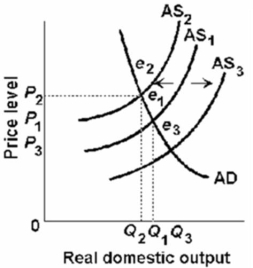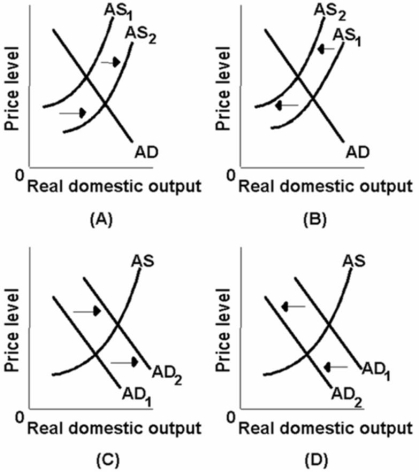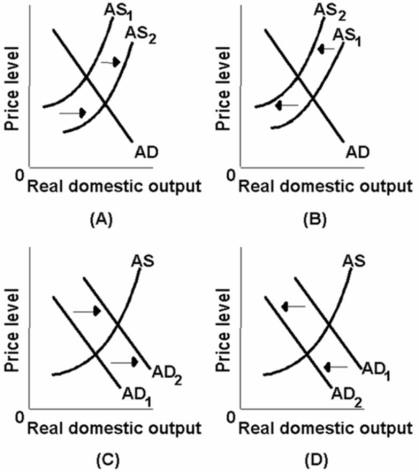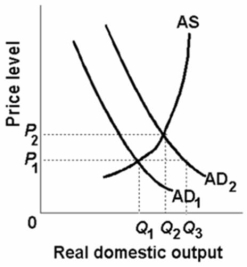A) the price level.
B) aggregate demand.
C) an aggregate supply determinant.
D) the quantity of real output supplied.
Correct Answer

verified
Correct Answer
verified
Multiple Choice
The real-balances effect indicates that:
A) an increase in the price level will increase the demand for money, increase interest rates, and reduce consumption and investment spending.
B) a lower price level will decrease the real value of many financial assets and therefore reduce spending.
C) a higher price level will increase the real value of many financial assets and therefore increase spending.
D) a higher price level will decrease the real value of many financial assets and therefore reduce spending.
Correct Answer

verified
Correct Answer
verified
Multiple Choice
The long run aggregate supply:
A) is downward sloping.
B) is vertical.
C) is horizontal.
D) is upward sloping.
Correct Answer

verified
Correct Answer
verified
Multiple Choice
Refer to the diagram given below.  If aggregate supply shifts from AS1 to AS3, then the real domestic output will:
If aggregate supply shifts from AS1 to AS3, then the real domestic output will:
A) increase and the price level will increase.
B) increase and the price level will decrease.
C) decrease and the price level will increase.
D) decrease and the price level will decrease.
Correct Answer

verified
Correct Answer
verified
Multiple Choice
The following aggregate demand and supply schedules are for a hypothetical economy:  Refer to the above data.The equilibrium price level will be:
Refer to the above data.The equilibrium price level will be:
A) 150
B) 200
C) 250
D) 300
Correct Answer

verified
Correct Answer
verified
Multiple Choice
 Which of the above diagrams best portrays the effects of a decrease in the availability of key natural resources?
Which of the above diagrams best portrays the effects of a decrease in the availability of key natural resources?
A) A
B) B
C) C
D) D
Correct Answer

verified
Correct Answer
verified
Multiple Choice
The following aggregate demand and aggregate supply schedules are for a hypothetical economy.  Refer to the data above.The vertical range of the aggregate supply curve is associated with price levels:
Refer to the data above.The vertical range of the aggregate supply curve is associated with price levels:
A) 150 and 200.
B) 150 and 300.
C) 200 and 250.
D) 250 and 300.
Correct Answer

verified
Correct Answer
verified
Multiple Choice
 Which of the above diagrams best portrays the effects of an increase in productivity?
Which of the above diagrams best portrays the effects of an increase in productivity?
A) A
B) B
C) C
D) D
Correct Answer

verified
Correct Answer
verified
Multiple Choice
A change in the price level products a?
A) The real-balances effect
B) The nominal-balances effect
C) The interest-rate effect
D) The foreign-trade effect
Correct Answer

verified
Correct Answer
verified
Multiple Choice
When deriving the aggregate demand (AD) curve from the aggregate expenditure model, an increase in Canadian product prices would cause:
A) an increase in the value of household wealth and reduced consumption expenditures.
B) an increase in interest rates and lower investment expenditures.
C) an increase in exports and imports.
D) an increase in Canadian resource prices and an increase in aggregate supply.
Correct Answer

verified
Correct Answer
verified
Multiple Choice
Refer to the diagram below.  Which of the following would shift the aggregate demand curve from AD2 to AD1?
Which of the following would shift the aggregate demand curve from AD2 to AD1?
A) A decline in personal income tax rates
B) An increase in the international value of the Canadian dollar
C) An increase in government spending
D) An increase in expected returns on investment projects
Correct Answer

verified
Correct Answer
verified
Multiple Choice
Suppose the full-employment level of real output (Q) for a hypothetical economy is $500 and that the price level (P) initially is 100.Use the following short-run aggregate supply schedules to answer the next question.  Refer to the information above.If the price level unexpectedly declines from 100 to 75, the level of real output in the short run will:
Refer to the information above.If the price level unexpectedly declines from 100 to 75, the level of real output in the short run will:
A) rise from $500 to $560.
B) fall from $500 to $440.
C) fall from $560 to $500.
D) rise from $440 to $500.
Correct Answer

verified
Correct Answer
verified
Multiple Choice
Other things equal, an improvement in productivity will:
A) shift the aggregate demand curve to the left.
B) shift the aggregate supply curve to the left.
C) shift the aggregate supply curve to the right.
D) increase the price level.
Correct Answer

verified
Correct Answer
verified
Multiple Choice
The relationship between the price level and the amount of real GDP is:
A) inverse.
B) positive.
C) no correlation.
D) perfectly correlated.
Correct Answer

verified
Correct Answer
verified
Multiple Choice
Menu costs will:
A) increase the amount of training of workers.
B) result in price wars between businesses.
C) increase the legal minimum wage.
D) make prices inflexible downward.
Correct Answer

verified
Correct Answer
verified
Multiple Choice
An economy is employing 2 units of capital, 5 units of raw materials, and 8 units of labour to produce its total output of 640 units.Each unit of capital costs $10, each unit of raw materials, $4, and each unit of labour, $3.Refer to the above information.The per unit cost of production in this economy is:
A) $.05.
B) $.10.
C) $.50.
D) $1.00.
Correct Answer

verified
Correct Answer
verified
True/False
The interest-rate effect is one of the determinants of aggregate demand.
Correct Answer

verified
Correct Answer
verified
Multiple Choice
The aggregate demand curve:
A) is upward sloping because a higher price level is necessary to make production profitable as production costs rise.
B) is downward sloping because production costs decline as real output increases?
C) shows the amount of expenditures required to induce the production of each possible level of real output.
D) shows the amount of real output which will be purchased at each possible price level.
Correct Answer

verified
Correct Answer
verified
Multiple Choice
In the short run, the aggregate supply curve of an economy is:
A) upward sloping.
B) downward sloping.
C) horizontal.
D) vertical.
Correct Answer

verified
Correct Answer
verified
Multiple Choice
An increase in household borrowing for consumption will:
A) decrease aggregate demand.
B) increase aggregate supply.
C) increase aggregate demand.
D) decrease aggregate supply.
Correct Answer

verified
Correct Answer
verified
Showing 81 - 100 of 203
Related Exams